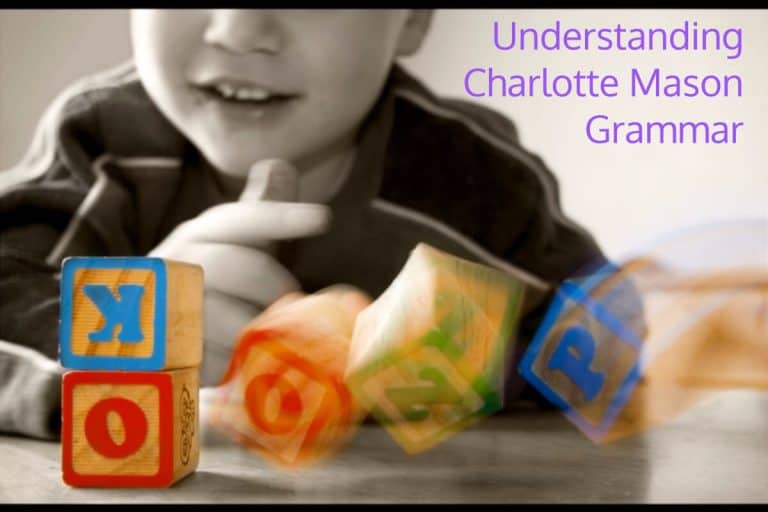Understanding Grammar - Charlotte Mason Method

When I was in second grade, I absolutely loved art and music class. I waited in anticipation all week for them. I loved to create, and I loved the feeling of unity as the entire class sang together. It was during these times that I felt completely engaged in life. I remember loving recess, of course, and spending time with my friends but what puzzled me for years was not what I did remember and love about second grade, but rather the absence of many memories at all in particular areas of my school experience.
What I Do Remember
I have absolutely not memories of grammar, spelling, or writing, except learning cursive, until I was in the fifth grade. That’s five whole years of my childhood education with no memories of these areas. I only remember cursive because it was an art form to me. I remember learning to read because I struggled with it immensely. I remember loving books later, though, and reading was my favorite hobby from the third grade on.
I remember math, social studies, and science but I don’t ever remember the term noun or verb being said to me until fifth grade. I’m sure that they were; grammar is a huge part of early childhood education in public schools. It just had no retention of it until the fifth grade.
Grammar in One Year?
The morning of my first day in fifth grade, I walked into my English/Grammar class and there on an enormous bulletin board, were the eight parts of speech labeled and defined in bright bold colors. They were beautiful to me and I understood them immediately. When I looked at the word adverb, the word itself rang a bell but had no recollection of what it meant. I looked at that board every day and within a week had the entire thing memorized.
That year, I gained all of the knowledge of grammar that I had up to that point and all that I would ever need or use from that point on; all in one year when I was ten.
Delaying Grammar
This childhood occurrence greatly influenced my perspective and approach to teaching grammar later on. I had many questions like ‘What do I teach until fifth grade?’ and ‘What do I teach when grammar is mastered?’
When I discovered the Charlotte Mason Method of teaching, I realized that she, too, had watched children experience a delay in the grasp of grammar concepts until age ten.
As I studied her approach to teaching grammar, I discovered the answers to my questions.
The overall approach is divided into three segments (in my own words): reading and writing, grammar, and practicing for real life. When you approach grammar in this way, you will not only find it highly successful but also that it comes very natural and is enjoyable to you and the child.
What to Teach In The Younger Years
Young children love books and stories and can do copywork and oral narration very well. From Kindergarten through fourth grade, these should be the foundation of their grammar preparation. Grammar is largely abstract concepts. These are difficult for young children to grasp and therefore, as I did as a child, they will simply let it go in one ear and out the other.
Introducing language as a whole helps the child better grasp grammar concepts later on.
When children are very young, read to them all the time. They need to be very familiar with many stories and be able to tell these stories in their own words (narration). They should be comfortable with how stories feel and how words work together.

Encourage them to write simple sentences about pictures that they see or draw starting in first or second grade. They don’t need to know how sentences are put together yet; they simply need to be immersed in a world of language. This builds a strong foundation and an understanding for things to come. By third grade, allow them to write about anything that interests them. You can slowly introduce the concepts of sentences and sentence parts.
How to Teach Charlotte Mason Grammar
Around age ten, abstract concepts begin to make sense to kids. This is a great time to start grammar. Slowly introduce the parts of speech and you will be surprised at how quickly and thoroughly your child comprehends them. If done properly, this process will only have to be done once with minimal review over the next few years, as needed.
Think of it as a mastery approach to grammar.
Using the Charlotte Mason principles, the passages used to learn the parts of speech, and other terms like synonyms and prefixes should come from great literature and inspiring works. One of the core concepts of her method is to always be introducing your child to ideas, as she called them.

Although you can easily make up your own curriculum to teach grammar, there are a couple of great resources that I like. For the early years, I like Sheldon’s Primary Language Lessons and Primary Language Lessons by Emma Serl. These are public domain books, and you can find them free to download. Starting in the third grade, I recommend Using Language Well by Simply Charlotte Mason.
Teaching Grammar in High School
High school should be a time that is used to prepare for life as a whole. One of the most useful skills that I teach now is writing. To be able to express yourself and be creative are essential skills to have as an adult and so most of the high school years are spent learning to use the grammar concepts and rules learned in Middle school. Essays, written narrations, and research projects are all assignments that are the bulk of our high school language arts curriculum.
You will find that teaching grammar using this method is really easy and fun. This approach makes great writers who are able to express themselves well. By utilizing all of those years before formal grammar teaching, you lay a better foundation for them which enables them to learn and retain what they have learned when the time comes.







Leave a Reply